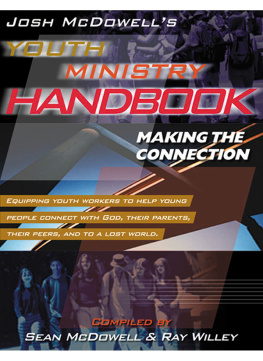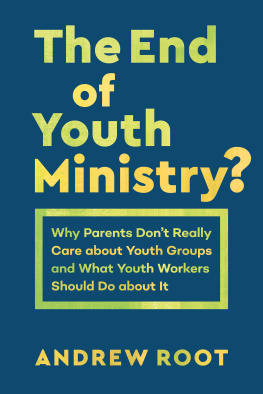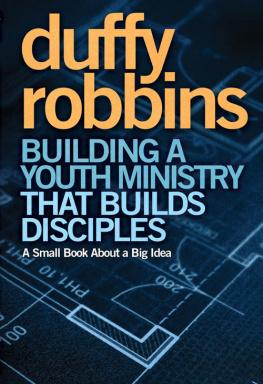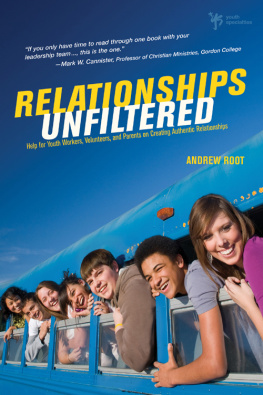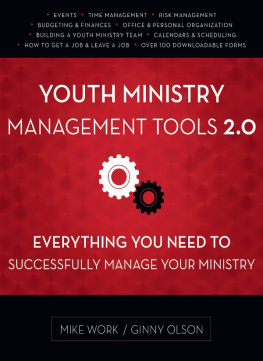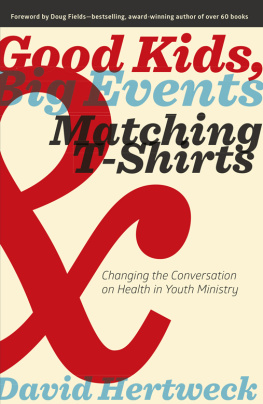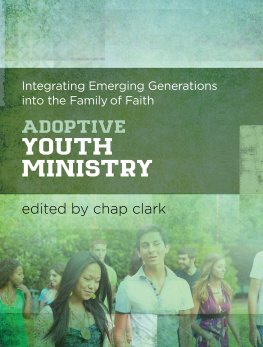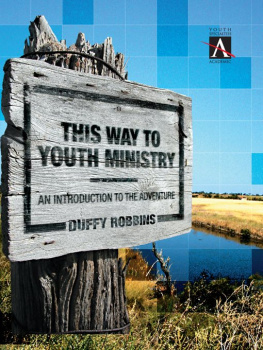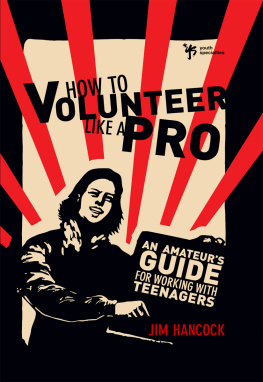Acknowledgments
It takes a village to raise an author especially this author.
Writing scared me. I never had confidence in writing or thought about writing for publication until Chap Clark encouraged me to do so. I trusted Chap, and I met with Tabitha Plueddemann (a freelance editor) to see if I had anything worth publishing. She was more excited about this book than I was, and she connected me with Julie Cramer (another freelance editor), who became my writing therapist and friend, counseling me into a whole new way of writing and engaging my audience. Without the encouragement and support of Chap, Tabitha and Julie, I would have never attempted to write, and this book would not exist.
Thanks to Chap Clark and Kenneth J. Gergen for writing the foreword and afterword. Their positioning as bookends to this book are significant. Chap represents practical theology to youth; Ken is the Dalai Lama of social constructionism. This book is a blending and integration of the two.
Thanks to Rachelle P. McKoy, my wife, friend and coauthor of many amazing life stories. You have been my greatest inspiration concerning the depth and value of relationships. Our struggles, accomplishments and many dialogues are laced throughout this book.
Kaden and Makenzie McKoy, you call me into being as daddy. Although you are both young at the completion of this book (Kaden, age eight, and Makenzie, age five), you have taught me more about the power and influence of stories and language during infancy and childhood than anyone else. I look forward to all of the stories we will create in our future.
Mom and Dad McKoy, and Mom and Dad Pettit: Thank you for your encouragement, love and support. The process was made easier knowing that I have two loving families who supported me every step of the way.
Ned Buckner, my former pastor and friend: Your support and encouragement throughout writing this book was a constant source of strength. You truly exhibit the love of God in all that you do. You taught me how to relationally engage people by looking into their eyes and valuing them as Gods precious creationespecially those who do not value love.
New Hope Baptist Church in Gastonia, North Carolinamy church familythank you for embracing me and sharing Gods love with our surrounding area.
My youth (current and previous): Thank you for teaching me how to be a minister. I have changed your names in the book and, due to confidentiality, I have split some of the stories. You will recognize many of our stories, and I consider it a great privilege to journey with you through many dangers, toils and snares in becoming more like Christ.
Gardner-Webb University (faculty and students): Thank you for inviting me to teach and implement much of this book in my youth discipleship classes. The conversations with my students were vital in the formation of this book. You all rock!
Fuller Theological Seminary: Thank you for providing a doctorate program in youth, family and culture that supported the integration and exploration of cutting-edge ministry practices. Much love to Chap and my cohort family that tolerated my obsession with narrative and my incessant comments and questions.
Thanks to the many conversation partners who have been a valuable resource in the completion of this book: Todd Bolin, Kent Blevins, Andy Smith, Mike Sears, Steve Knight, Josh Berryhill, Dennis Teal-Flemming, Jonathan Hale and my theologically diverse and lively Sunday morning class.
I would also like to thank the InterVarsity Press staff and Dave Zimmerman. Taking on a first-time author is risky business. Dave patiently walked me through my first book, and the IVP staff worked cohesively as a team to offer the reader the best work possible.
Finally, I would like to thank the reader. You may be someone I know, someone I will meet or someone I will never know personally. Regardless of our relationship, the words in this book and my role as an author come into existence because of you. Thank you for keeping this work alive.
Afterword
As Brandon McKoy opened this inspiring work, Even when a story reaches its last sentence, its impact continues in the lives of those who have participated in its reading, telling and living. These words drew me into fond reverie, as I returned to warm memories of Brandons participation in the home workshops Mary and I conduct in social constructionist thought. The intense sharing that had taken place during those hours did not terminate with his departure. Indeed, within this work those searching dialogues are now revitalized. And this new life is not simply a replica of the past; it is a multi-hued transformation. The abstract ideas we shared thereon socially constructed worlds, narrative, the primacy of relationship, multiple being, the co-construction of meaning and the likehere now acquire living flesh. As the ideas are settled into the context of youth ministry, with all its abundant and complex challenges, they acquire new and unimagined potentials. We find the ideas playing out concretely in the lives of Angela, Blake, Lisa, Todd, and a host of other young people, and in Brandons life as wellboth in his recollections and in his professional actions. And we see how the ideas can deeply enrich the potentials of the youth ministerand possibly all of our potentials for living our daily lives. Here indeed is a transformation of what took place in those workshops. I imagine here a form of resurrectionin rebirth, a transcendence.
I am also moved into further dialogue by this innovative work. So often I simply wish to respond in affirmation: Yes, yes, Right on target, Brilliant! But there are moments as well in which I want to take the conversation further. I want to ask, for example, about the narratives of resistance that we so often encounter among youth, the tales they secretly tell to each other that ensure they are all unified against the systemthe school, parents, even the law. How should we access and respond to these narratives as they function both to divide and unite?
I wonder as well, what we should do with the unarticulated worlds of many youthnot their narratives but their lack of narrative engagement. Their silence is also a language, but how shall we coordinate with such a language in such a way that more promising futures may emerge?
And finally, how are we to relate beyond the coordination of speaking and listening? To be sure, these verbal exchanges are enormously important, but the relational practices that foster such sharing, and are in turn invited by them, deserves expanded attention. There are some good conversations invited here.
I also emerge from this text inspired by the relationship into which Brandon has invited me. Now I am the learner! He develops ideas in this text that to my knowledge are nowhere to be found in the voluminous literature on narrative and associated practices of therapy and mediation. There are volumes available on narrative reconstruction, for example, but Brandon introduces the novel idea of helping youth to imaginatively extend the future trajectory of their narrative accounts. What happens if the story goes on in this or that way? In imagining future outcomes, Brandon writes, one may overcome complacency, apathy and indifference, and grow with the possibility of envisioning Gods future reality. Brandon goes on to show how biblical stories, and most especially the story of Jesus, can be folded into and enrich the stories that youth tell about themselves. Here too is a creative contribution to our understanding of narrative and its practical potentials. Rather than treating the personal narrative as solidified and intact, Brandon asks us to consider ways in which stories can be reformed in the context of reading or listening to other stories. The possibilities here are fascinating.
Finally, I must express my deep appreciation for Brandons extending the implications of my work into the domain of religion. My writings on social construction and relational being are largely secular. And as many religiously faithful readers discover (and Brandon points out), these ideas can form a bracing challenge to their faith. My writings were never intended to destroy peoples beliefs so much as to generate a shared consciousness in the ways in which we all participate in the making of these beliefs. Informed by this consciousness, the hope is to soften the boundaries of difference, to recognize the vulnerabilities in our beliefs, and encourage mutual appreciation for the many forms of understanding available to us. All may potentially enrich the human condition.


